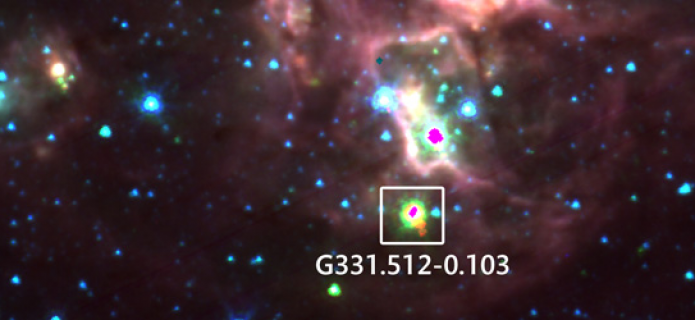ALMA reveals luminous birth in the Milky Way
2 September, 2013 / Read time: 5 minutes
Thanks to data detected with the ALMA radio telescope, the Atacama Large Millimeter/submillimeter Array, Chilean and foreign astronomers were able to detect a star in formation–a protostar–that appears to be one of the brightest and massive found in our galaxy.
Massive stars evolve rapidly, with a lifetime of just a few million years until they explode in a supernova. Their lives are short in comparison to stars such as the Sun, with a lifetime of 9 billion years. Because of this, massive stars are rare in our galaxy and little is known about their formation. However, they play a key role in the evolution of galaxies. "They are the main source of heavy elements and ultraviolet radiation, affecting the formation process of stars and planets, as well as the physical, chemical and morphological structure of galaxies," said the principal author of the study, Manuel Merello, a doctoral student at the University of Texas who holds a master's degree from the University of Chile. However, Merello added, "It's difficult to observe the 'birth' and early phases of this type of star, so being able to do this with ALMA helps us better understand the interaction between the radiation and wind generated by these kinds of objects with the interstellar medium that surrounds them in the very early stages."
The study focused on the observation of a giant molecular cloud known as G331.5-0.1, which is located in the Norma spiral arm, in the Milky Way, some 24,000 light years from Earth. "In the center of the molecular cloud we had discovered carbon emissions of speeds up to 100 km/s (360,000 km/h), but we didn't know how it was created" said Guido Garay, an academic with the University of Chile and member of the research team. "Today ALMA, with its extremely high sensitivity and fine angular resolution, allows us to study the physical processes occurring in these types of objects and find surprising things."
Using a tracer (to track the emission of silicon monoxide, SiO), the astronomers were able to observe collisions between the jet of gas ejected between the object and its environment, revealing the existence of a very massive, bright star in formation, which ejected jets of gas that were highly collimated (that is, in a very narrow cone).
The astronomers also found a second, lower-speed molecular structure with spherical symmetry. "It's like a shell," said Garay. The results of this study show that two types of stellar wind appear in the formation process of this star: a highly collimated one that generates the jet and another spherically symmetrical one that produces the shell, which is something never been seen before.
"Thanks to the high sensitivity and angular resolution of ALMA, scientists are now able to study the characteristics of formation of high mass protostars in a detail that could never have been done before," said Lars Nyman, ALMA Head of Science Operations and member of the research team.
More information
The research findings are presented in the article "ALMA observations of the massive molecular outflow G331.512−0.103,"published in the Astrophysical Journal, Vol. 774, of September 1, 2013.
The research team members are: M. Merello (University of Chile, University of Texas), L. Bronfman (University of Chile), G. Garay (University of Chile), N. Lo (Universidad de Chile), N. J. Evans (University of Texas), L. Nyman (Joint ALMA Observatory), J. Cortés (Joint ALMA Observatory), and M. R. Cunningham (University of New South Wales, UNSW).
The Atacama Large Millimeter/submillimeter Array (ALMA), an international astronomy facility, is a partnership of the European Organisation for Astronomical Research in the Southern Hemisphere (ESO), the U.S. National Science Foundation (NSF) and the National Institutes of Natural Sciences (NINS) of Japan in cooperation with the Republic of Chile. ALMA is funded by ESO on behalf of its Member States, by NSF in cooperation with the National Research Council of Canada (NRC) and the Ministry of Science and Technology (MOST) in Taiwan and by NINS in cooperation with the Academia Sinica (AS) in Taiwan and the Korea Astronomy and Space Science Institute (KASI).
ALMA construction and operations are led by ESO on behalf of its Member States; by the National Radio Astronomy Observatory (NRAO), managed by Associated Universities, Inc. (AUI), on behalf of North America; and by the National Astronomical Observatory of Japan (NAOJ) on behalf of East Asia. The Joint ALMA Observatory (JAO) provides the unified leadership and management of the construction, commissioning and operation of ALMA.
Contact:
Valeria Foncea
Education and Public Outreach Officer
Joint ALMA Observatory
Santiago, Chile
Tel: +56 2 2467 6258
Cell: +56 9 75871963
E-mail: [email protected]
Charles E. Blue
Public Information Officer
National Radio Astronomy Observatory
Charlottesville, Virginia, USA
Tel: +1 434 296 0314
Cell: +1 434.242.9559
E-mail: [email protected]
Lars Lindberg Christensen
Head, ESO education and Public Outreach Department
Garching bei München, Germany
Cell: +49 173 38 72 621
Email: [email protected]
Masaaki Hiramatsu
Education and Public Outreach Officer, NAOJ Chile
Observatory
Tokyo, Japan
Tel: +81 422 34 3630
E-mail: [email protected]
